 Open Access Article
Open Access ArticleCreative Commons Attribution 3.0 Unported Licence
Implementation of the Stockholm Convention on persistent organic pollutants (POPs) in Africa – progress, challenges, and recommendations after 20 years†
Olumide Emmanuel
Akinrinade
 *,
Foluso O.
Agunbiade
*,
Foluso O.
Agunbiade
 ,
Rose
Alani
and
Olusegun O.
Ayejuyo
,
Rose
Alani
and
Olusegun O.
Ayejuyo
Department of Chemistry, University of Lagos, Akoka, Nigeria. E-mail: emmanuelolu2004@yahoo.com
First published on 27th February 2024
Abstract
The Stockholm Convention on persistent organic pollutants is an effective global instrument for the eradication of hazardous chemicals known as persistent organic pollutants (POPs) in the environment. The Convention has so far been successful in the mitigation of worldwide POPs over 20 years of its entering into force. However, concerns still arise on POP-related waste management and elevating trend of POPs in Africa. Recent documents indeed indicated significant concentrations of POPs, particularly polybrominated diphenyl ethers (PBDEs) and polychlorinated biphenyls (PCBs) in a top global range or higher with a potential for this elevating trend to continue. The high concentrations and increasing trends are likely similar for the newly listed POPs, but current data are insufficient to examine this hypothesis. Several concerted efforts have been made by the Stockholm Convention Secretariat and relevant stakeholders to support POP eradication programmes in Africa but projections for the decline of many POPs are yet to be visible due to challenges of inadequate policy and regulatory frameworks, capacity to self-manage relevant socio-economic data and others as fully discussed in this review. Africa currently requires full range financial and technical support. We, however, highlight that for effective mitigation efforts, this support should be channelled into the development of capacity and competency to enable African-led programs for POP monitoring, waste disposal, and public awareness, rather than reliance on external groups. Harmonising economical, industrial development, scientific and political interests will be crucial to future self-sustainability of mitigation goals of the Stockholm Convention on POPs in Africa.
Environmental significanceThe current situations in Africa with few available reports indicate possible increasing concentrations of the Stockholm Convention-listed POPs (hazardous chemicals). Besides impact on human health/environment, high concentrations of POPs could significantly impact the global effort to eradicate POPs due to global distillation. Environmental mitigations of chemicals are strengthened by effective policies. This review examines the current state of POPs in Africa and highlights the influence of policies on the current situations after 20 years of the establishment of the Stockholm Convention on POPs. Information was on only a few POPs. However, the available information suggests the decline of some congeners/POPs while others are increasing. Relevant policies have limited focus on POPs, and the increasing trend will possibly continue. We provided current limitations and sustainable recommendations. |
1 Introduction
The Stockholm Convention (SC) on persistent organic pollutants is a global treaty with a primary focus on the protection of the environment and human health from hazardous chemicals known as persistent organic pollutants (POPs).1 The Convention was adopted at a Conference of Plenipotentiaries on 22nd May 2001 in Stockholm, Sweden, and entered into force on 17th May 2004.2 The main responsibility of each Party, according to Article 3 of the Convention, is to eliminate, restrict or reduce the release of POPs from production and intentional/unintentional use.2 Africa has approximately 1.46 billion population dominated by Nigeria (15%), Ethiopia (8.7%), Egypt (7.7%) and DR Congo (7.0%) (Fig. 1, S1 and Table S2†). Given that the global population is 8.045 billion, Africa has a share of about 18% of the global population.3,4 Presently, there are a total of 185 parties in the SC; besides South Sudan, all other fifty-three African countries are included in this list (Table S3†).5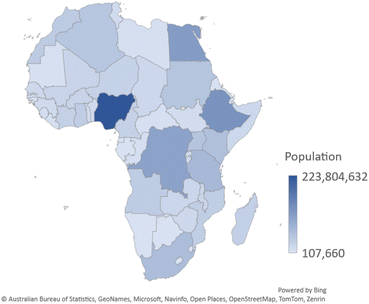 | ||
| Fig. 1 The African continent.4 | ||
The procedure for listing of POPs in the SC involves initial nomination of a candidate POP by the concerned Party based on selected criteria as itemised in Table S4† which can be summarised as severe toxicity, long-range environmental transportation, bio-accumulative tendency, and resistance towards environmental degradation. Following this nomination, the candidate POP is screened by the POP Review Committee (POPRC) who proffers recommendation to the Conference of Parties (COP) who take the final decision supported by other technical information. Twelve chemicals (‘dirty dozen’) were initially included in the SC but currently 19 additional chemicals have been listed at different COP meetings with 6 under proposal for inclusion. The latest POPs, perfluorohexane sulfonic acid (PFHxS), its salts, and PFHxS-related compounds were listed in 2022 (Table S1†).
According to the SC, POPs are classified as pesticidal, industrial, and unintentional POPs according to their uses/sources, or as Annex A (those targeted for elimination), B (those targeted for restriction), and C (unintentional production) based on their control measures (Table S1†). However, Article 4 of the SC specifies a list (registration) of acceptable uses of POPs within a specific time-frame on the basis of the request of the Party.2
The SC mandates each Party to provide a National Implementation Plan (NIP) detailing the Party's plan for the implementation of its obligation under the Convention within two years after the specific Convention enters into force. Parties are also required to update the NIP on a periodic basis as specified by the COP (Article 7).2,6 As of January 2024, NIPs for addressing the COP 9 (2019) amendments were still unavailable for the majority of countries globally, despite the more recent COP 10 (2021) and COP 11 (2023) meetings. In addition to the NIP, each Party is under obligation to provide five-year National Cycle Reports indicating measures and the effectiveness of such measures it has taken to implement the provisions of the Convention (Article 15). There is available assistance from the SC Secretariat, regional and sub-regional organisations, as well as the national stakeholders to support the Party in the development and upgrade of the NIPs. The SC also provides relevant guidance and UNEP toolkits for adequate POP inventories required for the NIP and National Reports.
According to the available documents,7 fifty-two African countries have currently submitted their NIPs but only about 9.8% of these countries have updated their NIPs on the basis of the COP 8 (2017) meeting and only one on the basis of the COP 9 (2019) meeting. The available NIPs as well as the National Reports indicated challenges significantly limiting the Party's obligations towards the Convention. In addition, recent literature data showed high and elevating trends of POPs such as BFRs and PCBs in Africa.8–12 Unfortunately, data are not fully available for many newly listed POPs. Continental-wide range data are also limited. Consistently high levels of POPs in Africa pose significant health risks and impact world-wide mitigation efforts due to global distillation. The overall objectives of this study are therefore to (1) detail the present challenges of POP mitigation in Africa and (2) proffer sustainable solutions to environmental sources of POPs in Africa.
2 Data acquisition
The data and information involved in this review were extracted from documents obtained from the Scopus database, Google Scholar database and Web of Science Core Collection. Search terms were varied but included (‘Africa’ or ‘individual names of African countries’) and (‘persistent organic pollutants’ or ‘Stockholm Convention’ or ‘individual names of the persistent organic pollutants’) and (‘environmental policy’ or ‘environmental standard’ or environmental regulations' or ‘environmental guidelines’). Data and information were also extracted from National Reports and NIP documents submitted by African parties.8,13 Data and information were only extracted from the latest National Reports available for the 2nd to 5th National Report Circle (Fig. 2) and the latest NIP available (Fig. 3). While the initial NIPs were available for fifty-two (52) African parties, the initial NIP document cannot be found for Equatorial Guinea, and South Sudan is not a current Party of the SC. Generally, NIPs for addressing the COP 9 (2019) amendments are unavailable for the vast majority of the countries globally, despite the more recent COP 10 (2021) and COP 11 (2023) meetings.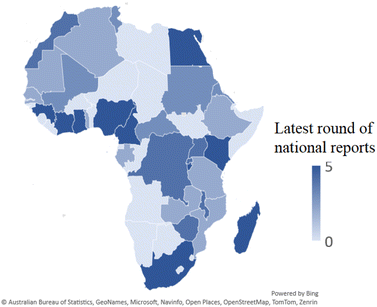 | ||
| Fig. 2 Latest round of National Reports as of 27th January 2024.7 | ||
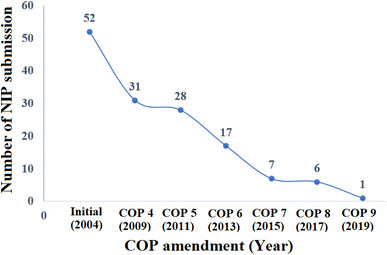 | ||
| Fig. 3 Number of NIPs from African parties addressing the COP amendment (as of 27th January 2024).13 | ||
3 Findings
3.1 Current temporal and time trends of POPs in Africa
The Global Monitoring Plan (GMP) is required to provide regional data and relevant information on POP concentration.14 These data and information are regularly updated on the GMP data warehouse.6 The data of the GMP's Africa regional POP monitoring reports (third phase)14 are mostly supported by the (i) Global Atmospheric Passive Sampling (GAPS) programme coordinated by Environment and Climate Change Canada for provision of ambient air data; (ii) MONET-Africa programme coordinated by RECETOX (Czech Republic) for provision of ambient air and water data; (iii) the World Health Organization (WHO) for provision of mothers' milk data, and (iv) UNEP/GEF GMP2 project coordinated by UNEP Chemicals for provision of additional data for ambient air, mothers' milk, water and other media.14Air is an important environmental parameter used for the measurement of the effectiveness of the SC due its sensitivity to polluted environments and high potential for transboundary pollutant transportation.15,16 In the third phase of GMP's report for POP concentrations in Africa (as of January 2020), annual decline of air levels of OCPs (aldrin, endrin, oxychlordane, heptachlor, p,p′-dichlorodiphenyldichloroethane (p,p′-DDD), endosulfan I, and γ-hexachlorocyclohexane (γ-HCH)) (≥5%), PCBs (PCBs – 28, 138 and 153) (2.1%), dioxin like-PCBs (PCBs – 105, 118 and 156) (1.4 to 4.2%), seven polychlorinated dibenzo-p-dioxins/polychlorinated dibenzofurans (PCDD/Fs) (2.6 to 7.9%), and PBDEs (BDEs – 28, 138 and 153) (0 to 3.5%) was recorded. However, no decline or significant trend was reported for BDEs – 17, 153, and 175/183, and PFAS (perfluoroalkyl and polyfluoroalkyl substance) compounds. The GMP data correspond with the recent MONET report16 on African air for OCPs (dichlorodiphenyltrichloroethane (DDT), HCHs, and endosulfan) and PCBs, reinforcing impacts of regulatory measures on the POPs; however, the concentrations of POPs such as PCDD/Fs and PBDEs have not significantly changed as reported by White et al.16 The constant levels of PCDD/Fs and PBDEs were attributed to the prevalence of open burning of waste, particularly WEEE (waste electronic and electrical equipment). These reports were in tandem with that of the POP Review Committee (POPRC) under the Stockholm Convention.17
Similarly, a recent two-year study (2017 to 2018) on 15 African countries among 42 targeted countries in the southern hemisphere by de Boer et al.18 indicated a decrease in DDT concentrations in African air; however, contrary to previous reports,14,16,17 an increase in PCB levels was reported. This difference was accorded to differences in sample locations. Generally, these studies14,16–18 implied prevalence of PCBs, PCDD/Fs and PBDEs in African continents. Interestingly, there was a decline in OCP concentrations which can be attributed to the historically high atmospheric concentrations of these POPs across Africa.
For other environmental media, both the POPRC17 and GMP14 noted limited global data to confidently evaluate time trends in regions such as Africa. However, the available time-trend data indicated decreasing concentrations of some legacy POPs in soil/sediment and aquatic organisms but increasing concentrations of some POPs in water, fish, fruits, and vegetables.19
Comparing African and global data, top-range or higher global concentrations of brominated flame retardant (BFR) and PCBs have been documented in African air.9–11,15,18 But the concentration of BFRs was lower in African indoor dust except around WEEE recycling sites.10 Similarly, concentrations of PCDD/Fs, PCBs, BFRs, OCPs, and PFASs in African total diet were reportedly lower or in a similar range to those in global studies.20
3.2 Production, uses, and sources of POPs in Africa
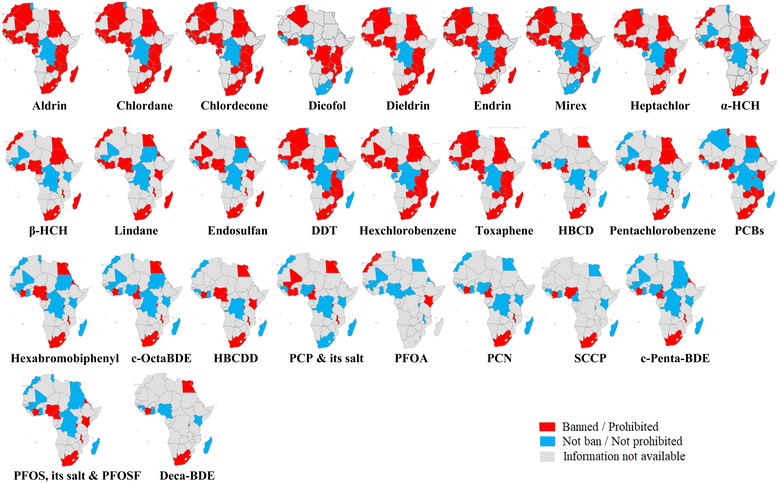 | ||
| Fig. 4 Outlook of legislation against POPs in African countries.7 | ||
Although no information is presently available on the current production of POP-pesticides in Africa, however, there is information on the historical manufacture of DDT in Tanzania until 1997.27 Toxaphene, aldrin, dieldrin, endrin, technical endosulfan, and DDT were produced in Sudan prior to 2001.28 Historical pesticide formulations have also been reported in Ethiopia,17 Nigeria,29 Zambia (DDT, dieldrin, and aldrin),30 and South Africa.17 Several African countries have however discontinued the use of POP-pesticides including DDT for vector control. However, DDT is still reserved in some African countries due to its efficiency against malaria vectors, high residual time and less proneness to vector resistance compared to the available alternatives. The use of DDT has generally declined by 79% worldwide since the SC came into force. India was historically the largest producer of DDT and remains the only producer today.7
Current environmental sources of POP-pesticides in Africa were linked to stockpiles and hot spots from historical applications, misapplication, poor storage, and disposal. Several NIPs reported continuous informal sales, transportation, and applications of POP pesticides under guise of wrong labels or being unlabelled. The continuous use of these chemicals was associated with their potency and cost effectiveness.7 While POP-pesticides are not likely to be currently formulated or manufactured in Africa, illegal movement of the chemicals occur across the continents through porous borders.
Unfortunately, overall pesticide management is relatively low across many sections of the continent. Used pesticide containers and bags have been reportedly involved in alternative purposes including food and water storage.25,40 POP-pesticides such as lindane (in the form of Gammalin 20) and endosulfan have been reportedly applied in fish harvest and food preservation.40,44
Information is still missing on the epidemiological studies relating pesticide use to specific diseases. However, in Nigeria, there was a report of pesticide poisoning of 120 students after intake of lindane-contaminated beans in Gombe.44 There were also reports of hospitalisation of an entire local chief family after consumption of lindane preserved leaves.44 In Sierra Leone, death and diseases were reportedly more frequent in communities who applied pesticides than the communities who did not applied or used pesticides.40
DDT remains a valuable health tool against malaria across Africa, particularly in regions where malaria is most prevalent and where other alternatives have short residual effects.7 A dilemma therefore exists on the continuous application of DDT for public health security and environmental implication of DDT application. The way forward with regard to the dilemma is the development of environment-friendly alternatives while reserving DDT application under guidance for endemic situations. Close surveillance is recommended for these alternatives to avoid vector resistance. Some countries in addition have DDT stockpiles to avoid malaria resilience, emergencies, and for routine vector control.7
Several DDT alternatives are currently available. Bendiocarb, a carbamate insecticide, is a major DDT alternative applied as an indoor residual spray (IRS) in many parts of Africa. Although less effective than DDT,31 it poses fewer environmental impacts and possesses low bioaccumulation properties.25,31 Pyrethroid-based alternatives such as permethrin, alphacypermethrin, and deltamethrin have been used in impregnated mosquito nets, as well as indoor residual spray in African countries. Malathion, an organophosphate-based insecticide, has also been effective against malaria vectors in Africa.31–33
There are several global and regional efforts for malaria eradication, replacements of DDT, and consequential safe disposal of DDT stockpiles, for example, through the promotion of integrated vector management, promotion of alternative vector control products, insecticide resistance monitoring, capacity building for vector surveillance in Africa, and evidence-based decisions to improve the effectiveness of vector control.31 The strategic efforts include support from the Secretariats of the SC; the AFRO II3 project implemented by the UNEP and executed by the WHO Regional Office in Africa; as well as ‘African ChemObs6’ implemented by the UNEP for the Global Environment Facility and executed by the Africa Institute.17
In agriculture, POP-pesticides have been replaced by biodegradable alternatives such as orthene, decile, chlorpyrifos, fenitrothion, temik, phostoxin (fumigant), pyrethroids and organophosphates.31 However, pesticides in general are considered for use under guidance and caution. For example, phostoxin comprising aluminium phosphide reacts with water to form phosphine, a toxic gas.34 The Nigerian government issued a precautionary warning on the use of phostoxin following the death of three Zimbabwean children after inhalation of the pesticide used in maize preservation.35
Biological pesticides indicate another effective control measure. Bio-pesticides derived from micro-organisms and plants (neem, pyrethrum, etc.) have been effectively applied. Similarly natural enemies of pests such as homoptera of the family Eulophidae have been used against sugarcane borer (Sesamia nonagrioides) in Cabo Verde.36 Pyrethrum, a flower-based insecticide majorly produced in Kenya (>80%), has been used extensively. Enzymes (proteins), natural plant regulators, insect growth regulators, and semi-chemicals such as insect sex pheromones have all been applied as biopesticides.32
Countries such as Gambia and Rwanda have also adopted routine hygiene and sanitation for vector control methods.25,33 These available alternatives are significantly improving and in addition to global alliance indicate less dependence of African countries on DDT against malaria.17,31–33
HBB was used under the trade names FireMaster BP-6 and FireMaster FF-1 in commercial products in the 1970s.37 Although listed in Annex A of the SC, the HBB level is generally assumed to be negligible in most African environments. This was attributed to less production (likely <10![[thin space (1/6-em)]](https://www.rsc.org/images/entities/char_2009.gif) 000 tons) and application mostly limited to the 1970s. Most HBB contaminated materials are therefore likely to have reached their end-of-life cycle.25,32,37,38 HBCDD was mainly applied as a flame retardant in expanded foam used as building insulation in a temperate environment;15 therefore, levels and exposure risk to HBCDD are likely to be minimal in Africa24,38 at least in comparison with temperate environments such as Europe where flame retardants are required in thermal insulation foams due to high fire safety requirements. However, HBCDD-impacted thermal insulation materials are likely to be imported in commercial products or used in transportation vessels such as ships, thus increasing the possibility of higher concentrations in related environments.15
000 tons) and application mostly limited to the 1970s. Most HBB contaminated materials are therefore likely to have reached their end-of-life cycle.25,32,37,38 HBCDD was mainly applied as a flame retardant in expanded foam used as building insulation in a temperate environment;15 therefore, levels and exposure risk to HBCDD are likely to be minimal in Africa24,38 at least in comparison with temperate environments such as Europe where flame retardants are required in thermal insulation foams due to high fire safety requirements. However, HBCDD-impacted thermal insulation materials are likely to be imported in commercial products or used in transportation vessels such as ships, thus increasing the possibility of higher concentrations in related environments.15
Commercial production of PCBs existed between 1929 and 1993, and from 1985, PCB application and marketing have been heavily restricted in Europe.39 Commercial applications of PCBs originally involved closed applications (electrical transformers, electrical capacitors, lighting ballasts, and motor start capacitors in electrical equipment such as televisions, electric motors, and electromagnets), partially closed applications (heat transfer fluids, hydraulic fluids, vacuum pumps, switches, voltage regulators and circuit breakers) and open applications (lubricants, casting waxes, surface coatings, plastic, adhesive, and inks).40
PCBs were mainly applied in transformer oil (48%), followed by small capacitors (21%), open applications (21%), and other closed applications (10%).31 Current environmental sources of PCBs in Africa were attributed to leakages of transformer oils.13 Open applications such as paints, sealants, aseptic soaps (mainly in hospitals), pesticides, and various hydraulic fluids were assumed to have negligible emissions as a result of less use impacted by high cost implications within the application period.25 Import/export data of these materials and their PCB compositions were also not readily available for adequate inventories.21 Similarly, most African countries have inadequate data on the amount and nature of the contamination of the transformer oil which significantly undermines PCB mitigation efforts.21,25 Transformers of larger capacitors predating 1986 were generally assumed to be PCB contaminated.27 Transformer oils have been reportedly sold for alternative uses such as coolants for welding machines, in adulterated diesel, and as cheap cooking oil.21,24,25 Information on non-aroclor PCB sources is limited across Africa.15
Fire-fighting foams were regarded as major environmental sources of PFASs in Africa particularly fluoro protein foam (FFFP) and aqueous firefighting foams (AFFF). PFOS was mostly applied as fire extinguisher on combustion of liquid hydrocarbons by isolating oxygen atoms from the combustion region.41 PFOS, its salts, and PFOSF are fully fluorinated compounds with the perfluorinated carbon chain possessing hydrophobic and hydrophilic properties which repel grease and water molecules. They are therefore important in surface-active applications such as fire-fighting foams, medical X-rays, waterproof textiles, aviation hydraulic fluids, electroplating, pulp and paper, and synthetic carpets.24,38
The environmental sources of PFASs are in addition to fire-fighting foams associated with PFAS-impacted materials. Most of the PFOS-impacted materials such as synthetic carpets, paper, leather, nylon fibers, and textiles, particularly those used between 1980 and 2002 when PFOS was in high production and application volume25 were assumed to have exceeded their life span and ended as wastes in a dumpsite/landfill. Most manufacturers exempted PFOS from their production since 2003.22 Articles such as synthetic carpets have a long-duration and are likely to be in continuous use;42 however, data for these articles were not available in most of the NIPs. Higher PFOS concentrations have been reported in imported synthetic textiles and leather articles as well as wastes of synthetic textiles, leather and carpets collected from dumpsites in Uganda.22 Wastes associated with hydraulic fluids were reported as a major PFOS source in Kenya,32 but aviation hydraulic fluid was considered insignificant in Gambia.25 N-EtFOSA is the only known PFOS-related insecticide. The concentration of this insecticide was assumed to be negligible in most African countries. Its presence was however reported in Gambia.25
PBDEs were majorly applied as flame retardants in polyurethane foams (PUFs) and electronic and electrical equipment (EEE). The commercial-octa-PBDE formulation (comprising hexa- and hepta-BDE congeners) has been associated with the polymeric fraction of cathode ray tube (CRT) monitors of TVs and computers predating 2005. Judging from the regulation of this chemical from 2004, it is unlikely to be present in recent flat screens.24 The CRT monitors contain >50% of the POP-PBDEs in EEE.29 A commercial-penta-BDE formulation (comprising tetra- and penta-BDE congeners) was in major use between 1970 and 2004 and majorly applied in PUF (90 to 95%) used partly in automotives and upholstery. Automobiles – cars, trucks, and buses – have the major share (∼37%) of the PBDE applications. Generally, applications of c-penta-BDE in automobiles depend on the National/Regional Legislation and Production/use patterns.24 The average lifespan of furniture PUF in industrial countries is ∼10 years24 after which such articles are recycled or destroyed depending on the accumulated POP concentration. The average life span of furniture PUF is likely to significantly exceed 10 years in Africa. In addition, PUF in furniture, vehicles, and end-of-life articles could be potentially reused for different purposes orchestrating multiple cycles of contaminated PUF. Contaminated PUF is therefore currently likely to be in circulation in Africa.
The major PBDE inflow in Africa was attributed to contaminated consumer goods such as vehicles, sofa covers, textiles, and electronics. Current emission sources were therefore associated with these products in their various life cycles. Products manufactured in Africa were regarded as less contaminated or contamination free; meanwhile, high contaminations were assumed for products imported from countries with a high fire regulatory standard.13 Inventories on PBDEs are limited on textiles and buildings.7
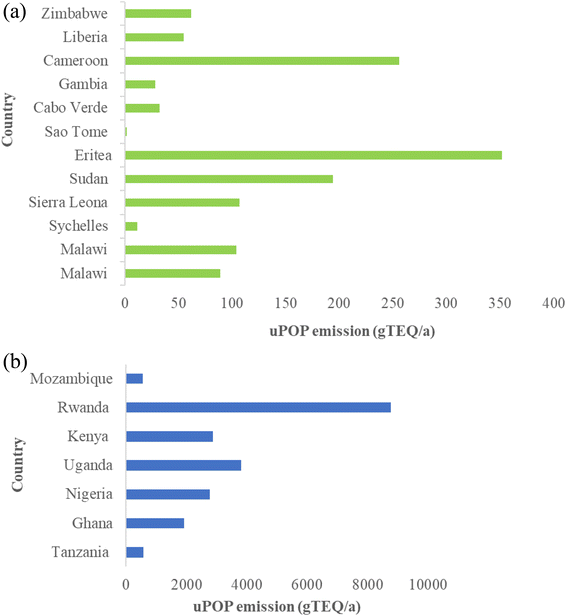 | ||
| Fig. 5 Concentrations of uPOPs in 19 African countries.13 (a) Concentrations of uPOPs in African countries (where uPOP < 500 TEQ per a). (b) Concentrations of uPOPs in African countries (where uPOP > 500 TEQ per a). | ||
3.3 Contamination sites
POP-pesticide contaminated sites were generally related to locations where those chemicals have been previously formulated, stored, or excessively applied such as wood-treatment sites. These sites have not been fully documented due to technical capacity and relevant equipment.7PCB contaminated sites were associated with storage facilities for obsolete/defective/decommissioned transformers particularly mega transformers predating 1986 or where those transformers or transformers that have been previously serviced with contaminated oils were in current operation. PFAS hotspots were associated with locations such as storage, training or airport maintenance areas where hydraulic oils or fire-fighter foams have been previously applied.42 Hotspots of flame retardants such as PBDE and HBCDD were associated with dumpsites and informal recycling facilities comprising end-of-life vehicles, WEEE, furniture foams, and textile materials, and backyards where those products have been mismanaged.21,22,41,43
uPOP contaminated sites include locations of activities such as uncontrolled open domestic/municipal waste burning and waste incinerations as well as where uPOP-related chemicals, such as PCBs have been previously applied/stored. Dumpsites and landfills were generally identified as leading POP hotspots.21,24,26,32,37
3.4 Available regulatory guidelines for POPs in Africa
Tables 1 and 2 show the few available POP regulatory guidelines found for Africa. These guidelines, though targeting some relevant POPs in different environmental media, are old, few, and not relevant for many old and newly listed POPs. The regulatory guidelines available in other regions such as Europe and the United States48–51 (Tables S6–S8†), are robust and relevant but might not sufficiently accommodate the unique African environmental and social-cultural situations. Extreme reliance on these guidelines can lead to over or underestimation of exposure risk assessment of POPs in Africa. African specific POP guidelines will therefore project better exposure/health risk assessments of POPs in Africa. Subject to detailed investigations, we hypothesised that the potential POP regulatory guidelines in Africa will vary compared with those of other regions/locations across several environmental media.| Country/environmental medium | Concentration of POPs (water – mg L−1; soil – mg kg−1; air – ppm) | ||||||||||
|---|---|---|---|---|---|---|---|---|---|---|---|
| PCBs | Endrin | Lindane | Methoxychlor | Toxaphene | Aldrin | Dieldrin | DDT | Endosulfan | PCP | PCDD/Fs | |
| Nigeria | |||||||||||
| Surface water | 0.003 | — | — | — | — | — | — | — | — | — | — |
| Groundwater | — | 0.004 | 0.0002 | 0.10 | 0.005 | — | — | — | — | — | — |
![[thin space (1/6-em)]](https://www.rsc.org/images/entities/char_2009.gif) |
|||||||||||
| Ethiopia | |||||||||||
| Soil | — | — | — | — | — | — | — | 1 | — | 0.5 | — |
![[thin space (1/6-em)]](https://www.rsc.org/images/entities/char_2009.gif) |
|||||||||||
| Egypt | |||||||||||
| Air | 50 | — | — | — | — | — | — | — | — | — | 1 |
4 Challenges and recommendations of regulation and management of the Stockholm Convention-priority chemicals in Africa
4.1 Challenges
(1) POP-pesticides are still illegally transported within Africa either as unlabelled or under the guise/label of unregulated brands. These chemicals were reported to be effective and cost-effective. Confiscated chemicals are commonly improperly subjected to low-temperature combustion which could further impact and degrade the environment.44(2) There are currently several unidentified stockpiles and hotspots of POP-related chemicals which could serve as potential emission sources.
(3) Although efforts are increasingly directed towards public sensitisation on health and environmental risks of POPs, the level of current public awareness is inadequate. There are also language barriers for POPs and many scientific information/names are difficult to decode by end-users/locals/farmers.
(4) There are limited continent-wide/country POP and socio-economic data for adequate POP inventories, monitoring and regulations.
(5) In many cases, countries have adopted chemical and environmental management in their overall policy establishment. These policies are mostly overseen by the Ministry of Environment or related agencies and supported by other ministries/agencies. However, these policies have larger environmental objectives with little focus on POPs. In addition, the institutional capacity and policy enforcement are mostly low. There are inadequate regulatory environmental standards or legal instruments for the prosecution of environmental law defaulters. Importantly, overlap of duties constitutes challenges in the overall implementation programmes.
(6) Balance and priority of public health, food production, industrial and socio-economic development over environmental and food safety are still conflicting issues. This is in addition to the need for safe alternatives to priority chemicals, particularly pesticides targeted against disease vectors. Many African countries still rely on old-mega transformers for the transmission of electric power. While a crucial timeline frame of 31 December 2025 has been established for the removal of all PCB-containing stocks from used equipment such as transformers, capacitors, and others containing liquid stocks, this crucial time boundary is not feasible for Africa.52
(7) There are inadequate technical capacities and facilities for POP monitoring, particularly the newly listed POPs such as SCCPs. Many African laboratories are under-equipped or not adaptable for proper monitoring of POPs due to high cost of equipment, maintenance, chemical standards and competency. This was reported for a larger percentage of the NIP. During the implementation of a GMP project, the laboratories nominated in Africa were found to be inadequately equipped and were disallowed to participate in this project.53 This concern was emphasised by Fiedler et al.54 where capacities for dl-POP analyses were reportedly limited in Africa in addition to central and European countries.
(8) Lack of overall capacity for POP-waste collection and management. The SC and the European Union (EU) classified wastes containing ≥5 mg kg−1 of POPs as hazardous wastes that must be completely destroyed.55 However, equipment, facilities, and technical competencies to detect POPs and destroy such waste are largely not available in Africa. A larger percentage of recycling activities is in the informal sectors with little information on the environmental and health risk impacts of poor recycling activities. Wastes are mostly not separated and inappropriately managed at low-temperature in open dumpsites. This is aggravated by the increasing urban population with a consequential increase in waste volume.
(9) Economic challenges imply continuous reliance on used consumer products which are already approaching the end-of-life period and potentially contaminated with priority chemicals.
4.2 Recommendations
(1) Improvement of the overall socio-economic data including export/import data for more reliable and adequate inventory, planning, and monitoring of POPs.(2) Enhancement and building of existing environmental policies to capture POPs. We recommend that these policies should be consistently updated for current POPs. Such policies should oversee all articles from the cradle to the grave including recycling of materials, should be easily implemented, and must be locally and internationally relevant.
(3) Harmonising official and unofficial recycling activities to increase recycling efficiencies and lessen environmental and health burden of POPs.
(4) International, regional, and local support for the improvement of local capacities and competencies for the monitoring and management of POPs. We recommend that the listing of new POPs after the COP amendment should be followed by capacity building for the monitoring of such chemicals in developing countries, particularly in Africa. Regional and periodical interlaboratory assessments are required and should be consistent. Additionally, African laboratories should participate in relevant global inter-calibration/proficiency studies. According to the UNEP,56 44 laboratories in 16 African countries are listed among 256 worldwide laboratories targeted specifically for the POP data bank (Table S5†). The technical capacities and equipment of these laboratories and other laboratories should be enhanced and periodically double-blank-checked for adequate quality control/assurance and consistency to ascertain their competency for POP analysis. We recommend that more African scientists should be trained and be involved in the findings of POP alternatives particularly POP-pesticides and monitoring programmes for vector resistance.
(5) It is possible that some important POP-related data existed in Africa but such data are either unreliable or unreadily available due to insufficient peer-reviewed systems or obscurity in journals not internationally available. Publication of local content in internationally relevant journals or the upgrading peer-reviewed system and availability of local journals to global standards will be significantly beneficial.
(6) Increase in regular public awareness and sensitisation programmes on health and environmental impacts of POPs as well as the regulations and the means of environmental compliance. These awareness activities should discuss the hazardous impacts of POPs and the activities towards remediating the impacts particularly in local contents.
(7) Earmark global, regional, and local POP-targeted funds for Africa, similar to the current funding programmes of the UNIDO implemented by the GEF. We recommend that these funds be targeted towards the detection of POP hotspots/stockpiles, remediation of POP hotspots, timely disposal of stockpiles, public awareness programs, and overall management of POP-related articles.
(8) Improvement in regional coordination on POPs and BAT/BET (best available techniques/best environmental practices). An example is the Regional BAT/BEP Forum for Africa with major priorities of open burning of wastes and landfills, waste incineration, fossil fuel-fired utilities, industrial boilers, and the metallurgical industry. There can also be establishment of a POP monitoring programme under the direction of the African Union to work along with the regional centres and groups under the GMP. These options would in addition check the regularities and quality control of the adopted laboratories through interlaboratory quality checks and support monitoring, data collection, and disposal of POP-related articles.
(9) Establishment of African/national-unique environmental guidelines as instruments of regulations.
(10) Routine market checks are necessary for the detection of priority chemicals, particularly POP-pesticides.
(11) We recommend increasing collaborations between African countries and developed countries with additional support from the SC for routine POP screening and monitoring in imported consumer products, particularly used PUFs, EEE, and textiles. Emphasis should be placed on the description/coding system or harmonised system (HS) codes described in the Basel Convention on the control of transboundary waste and its disposal.
(12) Relevant epidemiological studies are required to fully understand the impacts of POP-chemicals on human health in Africa.
(13) Science and policy on POPs need to be harmonised among all stakeholders from policymakers to policy end users.
5 Conclusion
While POP-specific policies and regulatory frameworks are not readily available, the general environmental policies vary across Africa and tend to be skewed towards economic and political interest, prioritizing chemicals for specific purposes such as for malaria in endemic areas, and socio-economic needs including power production and the need for cheap used consumer products, particularly electronic and electrical equipment and textiles. Therefore, despite several attempts to eradicate/reduce POPs as a commitment of the Party's obligation to the Stockholm Convention on persistent organic pollutants, the overriding challenges indicate possible continuous emission of POPs in the nearest future. As part of primary interventions, we recommend additional financial and technical support for POP mitigation in Africa and such support should be prioritised for competency and capacity building on POP monitoring, waste disposal, and high-level public sensitisation programmes which are currently limited by language borders.Author contributions
Olumide Emmanuel Akinrinade: writing – original draft, writing – review and editing, visualisation, investigation, conceptualisation, methodology, validation. Foluso O. Agunbiade: writing – review and editing, conceptualisation, validation. Rose Alani: writing – review and editing, conceptualisation, validation. Olusegun O. Ayejuyo: writing – review and editing, conceptualisation, validation.Conflicts of interest
There are no conflicts of interest to declare.References
- M. Sharkey, S. Harrad, M. Abou-Elwafa Abdallah, D. S. Drage and H. Berresheim, Environ. Int., 2020, 144, 106041, DOI:10.1016/j.envint.2020.106041.
- United Nations Environment Programme (UNEP), Stockholm Convention on Persistent Organic Pollutants (POPs) – Text And Annexes, 2022, [Internet], [cited 2023 March 02], available from, https://UNEP-POPS-COPCONVTEXT-2021.English.pdf Search PubMed.
- Worldometers, African Countries by population, 2023, [Internet], [cited 2023 September 17], available from, https://www.Worldometers.info/population/countries-in-africa-by-population/ Search PubMed.
- Worldometers, Population of Africa, 2023, [Internet], [cited 2023 September 17], available from, https://www.Worldometers.info/world-population/africa-population/ Search PubMed.
- United Nations Environmental Programme (UNEP), Status of Ratification, 2019, [Internet], [cited 2023 April 21], available from, https://chm.pops.int/Countries/StatusofRatifications/PartiesandSignatoires/tabid/4500/Default.aspx Search PubMed.
- Z. Wang, S. Adu-Kumi, M. L. Diamond, R. Guardans, T. Harner, A. Harte, N. Kajiwara, J. Klánová, J. Liu, E. G. Moreira, D. C. G. Muir, N. Suzuki, V. Pinas, T. Seppälä, R. Weber and B. Yuan, Environ. Sci. Technol., 2022, 56(5), 2936–2949, DOI:10.1021/acs.est.1c06120.
- United Nations Environment Programme (UNEP), National Reports, 2019, [Internet], [cited 2024 January 27], available from, https://chm.pops.int/Countries/Reporting/NationalReports/tabid/3668/Default.aspx Search PubMed.
- R. Gioia, S. Eckhardt, K. Breivik, F. M. Jaward, A. Prieto, L. Nizzetto and K. C. Jones, Environ. Sci. Technol., 2011, 45(4), 1349–1355, DOI:10.1021/es1025239.
- C. Bogdal, M. Scheringer, E. Abad, M. Abalos, B. van Bavel, J. Hagberga and H. Fiedler, TrAC, Trends Anal. Chem., 2013, 46, 150–161, DOI:10.1016/j.trac.2012.05.011.
- O. E. Akinrinade, W. Stubbings, M. A. E. Abdallah, O. Ayejuyo, R. Alani and S. Harrad, Emerging Contam., 2020, 6, 405–420, DOI:10.1016/j.emcon.2020.11.005.
- A. Saini, T. Harner, S. Chinnadhurai, J. K. Schuster, A. Yates, A. Sweetman, B. H. Aristizabal-Zuluaga, B. Jiménez, C. A. Manzano, E. O. Gaga, G. Stevenson, J. Falandysz, J. Ma, K. S. B. Miglioranza, K. Kannan, M. Tominaga, N. Jariyasopit, N. Y. Rojas, O. Amador-Munoz, R. Sinha, R. Alani, R. Suresh, T. Nishino and T. Shoeib, Environ. Pollut., 2020, 267, 115416, DOI:10.1016/j.envpol.2020.115416.
- Y. Vasseghian, S. Hosseinzadeh, A. Khataee and E. Dragoi, Sci. Total Environ., 2021, 796, 149000, DOI:10.1016/j.scitotenv.2021.149000.
- United Nations Environment Programme (UNEP), National Implementation Plans, 2019, [Internet], [cited 2024 January 27], available from, https://chm.pops.int/implementation/NationalImplementationPlans/NIPTransmission/tabid/253/default.aspx Search PubMed.
- Global Monitoring Plan (GMP), Global Monitoring Plan for Persistent Organic Pollutants under the Stockholm Convention Article 16 on Effectiveness Evaluation. Third Regional Monitoring Report – Africa Region, 2021, [Internet], [cited 2023 June 04], available from, https://chm.pops.int/implementation/globalmonitoringplan/monitoringreports/tabid/525/default.aspx Search PubMed.
- O. E. Akinrinade, W. Stubbings, M. A. E. Abdallah, O. Ayejuyo, R. Alani and S. Harrad, Environ. Res., 2022, 204(Pt B), 112091, DOI:10.1016/j.envres.2021.112091.
- K. B. White, J. Kalina, M. Scheringer, P. Pribylova, P. Kukucka, J. Kohoutek, R. Prokes and J. Klanova, Environ. Sci. Technol., 2021, 55, 9413–9424, DOI:10.1021/acs.est.0c03575.
- United Nations Environment Programme (UNEP), Preliminary report for the effectiveness evaluation of the Stockholm Convention pursuant to Article 16 UNEP/POPS/2022/EEC.1/3, 2022, [Internet], [cited 2023 March 16], available from, https://UNEP-POPS-EEC.1_2022-3.English.pdf Search PubMed.
- J. de Boer, R. van Dijk, M. Abalos and E. Abad, Chemosphere, 2023, 324, 138271, DOI:10.1016/j.chemosphere.2023.138271.
- P. Bruce-Vanderpuije, D. Megson, E. J. Reiner, L. Bradley, S. Adu-Kumi and J. A. Gardella, Environ. Pollut., 2019, 245, 331–342, DOI:10.1016/j.envpol.2018.10.107.
- V. Vaccher, L. Ingenbleek, A. Adegboye, S. E. Hossou, A. Z. Koné, A. D. Oyedele, C. S. K. J. Kisito, Y. K. Dembélé, R. Hu, I. A. Malak, R. Cariou, A. Vénisseau, B. Veyrand, P. Marchand, S. Eyangoh, P. Verger, G. Dervilly-Pinel, J.-C. Leblanc and B. L. Bizec, Environ. Int., 2020, 135, 105413, DOI:10.1016/j.envint.2019.105413.
- Malawian National Implementation Plan (Addressing COP 8 Amendments), [Internet], [cited 2023 July 08], available from, https://www.pops.int/Implementation/NationalImplementationPlans/NIPTransmission/tabid/253/Default.aspx Search PubMed.
- Ugandan national implementation plan (Addressing COP 6 Amendments), [Internet], [cited 2023 July 08], available from, https://www.pops.int/Implementation/NationalImplementationPlans/NIPTransmission/tabid/253/Default.aspx Search PubMed.
- Eritrean National Implementation Plan (Addressing COP 4 Amendments), [Internet], [cited 2023 May 10], available from, https://www.pops.int/Implementation/NationalImplementationPlans/NIPTransmission/tabid/253/Default.aspx Search PubMed.
- Zimbabwean National Implementation Plan (Addressing COP 6 Amendments), [Internet], [cited 2023 July 18], available from, https://www.pops.int/Implementation/NationalImplementationPlans/NIPTransmission/tabid/253/Default.aspx Search PubMed.
- Gambian National Implementation Plan (Addressing COP 8 Amendments), [Internet], [cited 2023 July 18], available from, https://www.pops.int/Implementation/NationalImplementationPlans/NIPTransmission/tabid/253/Default.aspx Search PubMed.
- Mozambique National Implementation Plan (Addressing COP 8 Amendments), [Internet], [cited 2023 June 16], available from, https://www.pops.int/Implementation/NationalImplementationPlans/NIPTransmission/tabid/253/Default.aspx Search PubMed.
- Information on Multilateral Environmental Agreements (InforMEA), Tanzania Case Study, [Internet], [cited 2023 July 10], available from, https://UNEP-POPS-LEG-CASES-Tanzania.En.pdf Search PubMed.
- Sudan National Reports (Third round of party reports), [Internet], [cited 2023 July 10], available from, https://www.pops.int/Countries/NationalReports/ThirdRoundPartyReports/tabid/4470/Default.aspx Search PubMed.
- Nigerian National Implementation Plan (Addressing COP 6 Amendments), [Internet], [cited 2023 June 17], available from, https://www.pops.int/Implementation/NationalImplementationPlans/NIPTransmission/tabid/253/Default.aspx Search PubMed.
- Zambian National Implementation Plan (Initial NIPs), [Internet], [cited 2023 May 08], available from, https://www.pops.int/Implementation/NationalImplementationPlans/NIPTransmission/tabid/253/Default.aspx Search PubMed.
- Sao Tome and Principe National Implementation Plan (Addressing COP 5 Amendments), [Internet], [cited 2023 June 24], available from, https://www.pops.int/Implementation/NationalImplementationPlans/NIPTransmission/tabid/253/Default.aspx Search PubMed.
- Kenyan National Implementation Plan (Addressing COP 5 Amendments), [Internet], [cited 2023 July 18], available from, https://www.pops.int/Implementation/NationalImplementationPlans/NIPTransmission/tabid/253/Default.aspx Search PubMed.
- Rwandan National Implementation Plan (Addressing COP 5 Amendments), [Internet], [cited 2023 July 18], Available from, https://www.pops.int/Implementation/NationalImplementationPlans/NIPTransmission/tabid/253/Default.aspx Search PubMed.
- S. Shadnia, K. Soltaninejad, H. Hassanian-Moghadam, A. Sadeghi, H. Rahimzadeh, N. Zamani, A. Ghasemi-Toussi and M. Abdollahi, Hum. Exp. Toxicol., 2011, 30(3), 250–253, DOI:10.1177/0960327110384287.
- National Agency for Food and Drug Administration (NAFDAC), 2022, [Internet], [cited 2023 July 18], available from, https://www.nafdac.gov.ng/public-alert-no-009-2022-warning-against-the-use-of-aluminium-phosphide-560tb-pesticides/.
- Cabo Verdean National Implementation Plan (Addressing COP 6 Amendments), [Internet], [cited 2023 May 13], available from, https://www.pops.int/Implementation/NationalImplementationPlans/NIPTransmission/tabid/253/Default.aspx Search PubMed.
- Seychelles National Implementation Plan (Addressing COP 6 Amendments), [Internet], [cited 2023 July 18], available from, https://www.pops.int/Implementation/NationalImplementationPlans/NIPTransmission/tabid/253/Default.aspx Search PubMed.
- Cameroonian National Implementation Plan (Addressing COP 6 Amendments), [Internet], [cited 2023 July 18], available from, https://www.pops.int/Implementation/NationalImplementationPlans/NIPTransmission/tabid/253/Default.aspx Search PubMed.
- European Commission (EC), Polychlorinated Biphenyls and Polychlorinated Terphenyls (PCBs/PCTs), [Internet], [cited 2023 July 18], available from, https://environment.ec.europa.eu/topics/waste-and-recycling/pcbspcts_en Search PubMed.
- Sierra Leonenan National Implementation Plan (Addressing COP 6 Amendments), [Internet], [cited 2023 May 13], available from, https://www.pops.int/Implementation/NationalImplementationPlans/NIPTransmission/tabid/253/Default.aspx Search PubMed.
- Ghanian National Implementation Plan (Addressing COP 6 Amendments), [Internet], [cited 2023 May 13], available from, https://www.pops.int/Implementation/NationalImplementationPlans/NIPTransmission/tabid/253/Default.aspx Search PubMed.
- Sudan National Implementation Plan (Addressing COP 5 Amendments), [Internet], [cited 2023 June 05], available from, https://www.pops.int/Implementation/NationalImplementationPlans/NIPTransmission/tabid/253/Default.aspx Search PubMed.
- Liberian National Implementation Plan (Addressing COP 5 Amendments), [Internet], [cited 2023 July 18], available from, https://www.pops.int/Implementation/NationalImplementationPlans/NIPTransmission/tabid/253/Default.aspx Search PubMed.
- International POPs Elimination Project (IPEP), Stakeholders Reflection and Workshop on the Nigerian POPs Situation, 2006, [Internet], [cited 2023 June 05], available from, https://ipen.org/sites/default/files/documents/2nir_stakeholder_workshop_on_pops_in_nigeria-en.pdf Search PubMed.
- Federal Environmental Protection Agency (FEPA), Guidelines and Standards for Environmental Pollution Control in Nigeria, Federal Environmental Protection Agency Regulation 1991 on Pollution Abatement in Industries and Facilities Generated Wastes, 1991, vol. 110&127, p. 31 Search PubMed.
- Environmental Protection Authority and The United Nations Industrial Development Organization (EPA/UNIDO), Guideline Ambient Environment Standards for Ethiopia, 2003, [Internet], [cited 2023 June 16], available from, https://plasticsdb.surrey.ac.uk/documents/Ethiopia/RepublicofEthiopiaEPA(2003)AmbientEnvironmentStandardsforEthiopia.pdf Search PubMed.
- International POPs Elimination Project (IPEP), Country Situation Report for Egypt – Day Hospital Institute for Development and Rehabilitation, 2005, [Internet], [cited 2023 May 20], available from, https://ipen.org/sites/default/files/documents/10egy_egypt_country_situation_report-en.pdf Search PubMed.
- European Commission, European Commission Regulation (EU) 2019/1021 of the European Parliament and of the Council of 20 June, 2019 on Persistent Organic Pollutants (Recast), 2019, [Internet], [cited 2023 July 18], available from, https://eur-lex.europa.eu/legal-content/EN/TXT/HTML/?uri=CELEX:32019R1021 Search PubMed.
- European Commission, European Commission Directive 2013/39/EU of the European Parliament and of the Council of 12 August 2013 Amending Directives 2000/60/EC and 2008/105/EC as Regards Priority Substances in the Field of Water Policy, 2013, [Internet], [cited 2023 July 18], available from, https://eur-lex.europa.eu/LexUriServ/LexUriServ.do?uri=OJ:L:2013:226:0001:0017:en:PDF Search PubMed.
- Agency for Toxic Substances and Disease Registry (ATSDR), 2023 [Internet][cited 2023 June 24]. Available from, https://www.atsdr.cdc.gov/csem/polychlorinated-biphenyls/standards.html#:%7E:text=FDAmandatestolerancesof0.2,10ppm%5BFDA1996c%5D Search PubMed.
- United States Environmental Protection Agency (USEPA). Regional Screening Levels (RSLs) – Generic Tables, [Internet], 2023, [cited 2023 August 13], available from, https://semspub.epa.gov/work/HQ/404057.pdf Search PubMed.
- United Nations Environment Programme (UNEP), PCBs – Overview, 2019, [Internet], [cited 2024 January 27], available from, https://chm.pops.int/implementation/industrialpops/pcbs/overview/tabid/273/default.aspx Search PubMed.
- United Nations Environment Programme (UNEP), Terminal Evaluation of the Four UNEP GEF Medium Size (Projects: GEF ID GFL/2328-2760-4A37/4A76/4A77/4A80), 2013, [Internet], [cited 2023 June 05], available from, https://www.unitar.org/sites/default/files/media/file/gef.gmp2_.asia_.iws_.wd_.13.pdf Search PubMed.
- H. Fiedler, I. van der Veen and J. de Boer, Chemosphere, 2022, 288(1), 132449, DOI:10.1016/j.chemosphere.2021.132449.
- O. E. Akinrinade and W. Stubbings, J. Environ. Exposure Assess., 2022, 1(issue 4), 21, DOI:10.20517/jeea.2022.17.
- United Nations Environment Programme (UNEP). UNEP databank of laboratories analyzing persistent organic pollutants “pops laboratory databank”, [Internet], [cited 2023 June 05], available from, https://labs.pops.int/Laboratory/Search.aspx Search PubMed.
Footnote |
| † Electronic supplementary information (ESI) available. See DOI: https://doi.org/10.1039/d3va00347g |
| This journal is © The Royal Society of Chemistry 2024 |




